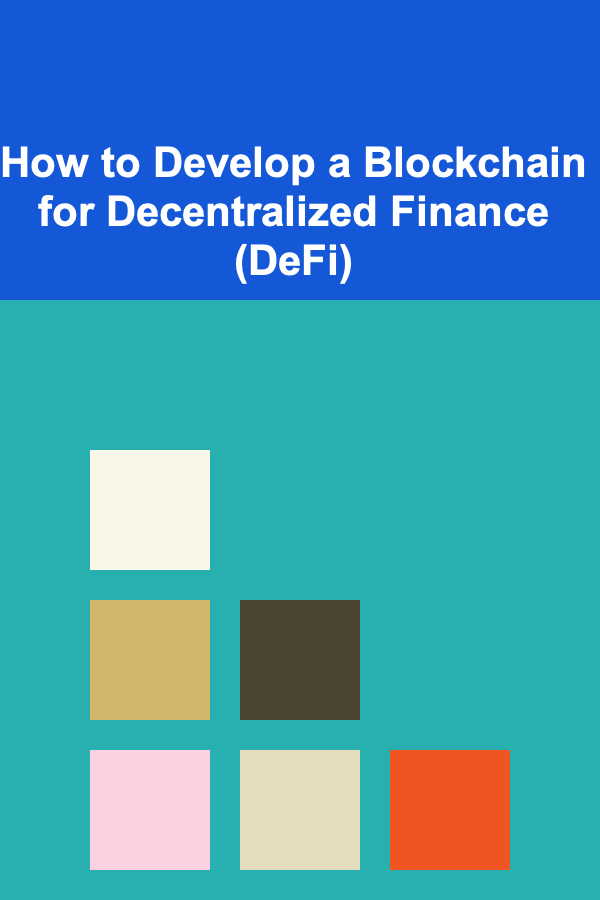
How to Develop a Blockchain for Decentralized Finance (DeFi)
ebook include PDF & Audio bundle (Micro Guide)
$12.99$10.99
Limited Time Offer! Order within the next:

In recent years, Decentralized Finance (DeFi) has emerged as one of the most transformative forces in the financial world. This ecosystem, built on blockchain technology, aims to provide decentralized alternatives to traditional financial services. DeFi protocols allow users to engage in lending, borrowing, trading, and yield farming without relying on centralized financial institutions like banks. But the question is: how do you develop a blockchain that supports DeFi applications? This article explores the essential steps, technologies, and considerations for building a blockchain designed for DeFi.
Understanding Blockchain for DeFi
Before diving into the development process, it's crucial to grasp the relationship between blockchain technology and decentralized finance. A blockchain, at its core, is a decentralized ledger that records transactions across many computers in a way that makes it nearly impossible to alter retroactively. DeFi applications leverage blockchain's ability to offer transparency, security, and immutability, all while removing intermediaries and enabling peer-to-peer (P2P) financial transactions.
In a DeFi blockchain, users can lend, borrow, trade, and perform other financial activities directly with each other using smart contracts. Smart contracts are self-executing contracts where the terms of agreement are written into code and automatically executed when conditions are met. This eliminates the need for intermediaries like banks, providing faster and cheaper financial services.
Key Components of a DeFi Blockchain
Before diving into the steps of building a DeFi blockchain, let's first outline the key components that a blockchain for decentralized finance should have:
1. Smart Contracts
Smart contracts are at the heart of any DeFi application. These are automated scripts that self-execute when predefined conditions are met. Smart contracts remove the need for trusted intermediaries, making transactions cheaper and more efficient.
For example, in lending and borrowing platforms, smart contracts automatically handle the transfer of collateral and interest payments between borrowers and lenders, ensuring that all conditions are met without human intervention.
2. Consensus Mechanism
The consensus mechanism determines how the blockchain reaches an agreement on the validity of transactions. For DeFi blockchains, it's crucial to choose a consensus mechanism that offers decentralization, security, and scalability. Common consensus mechanisms include:
- Proof of Work (PoW): Used by Bitcoin, it requires nodes to solve complex mathematical puzzles to validate transactions. However, PoW can be energy-intensive and slow.
- Proof of Stake (PoS): This mechanism selects validators based on the amount of cryptocurrency they hold and are willing to "stake" as collateral. PoS is more energy-efficient than PoW and is favored by many DeFi projects.
- Delegated Proof of Stake (DPoS): A variation of PoS, DPoS allows a smaller group of trusted nodes to validate transactions, improving scalability.
Choosing the right consensus mechanism depends on the desired trade-off between decentralization, scalability, and energy consumption.
3. Interoperability
One of the challenges of the DeFi space is the fragmentation of blockchain networks. Different DeFi applications often run on different blockchains (e.g., Ethereum, Binance Smart Chain, Solana), making it difficult for them to communicate with each other. A blockchain designed for DeFi should support interoperability, allowing seamless communication between different networks.
4. Scalability
As the DeFi ecosystem grows, so does the need for a scalable blockchain. DeFi platforms often require fast transaction processing to handle a large number of users and transactions. Solutions like Layer 2 protocols, sharding, and sidechains are commonly used to improve scalability without sacrificing decentralization.
5. Security
Security is paramount in the DeFi space. Since DeFi protocols deal with valuable assets, any vulnerabilities in smart contracts or the blockchain could lead to significant losses. Developers must implement rigorous testing, code audits, and implement mechanisms like multisig wallets and insurance funds to safeguard assets.
6. Privacy
While blockchains are inherently transparent, privacy is a growing concern in DeFi. Developers may choose to integrate privacy-enhancing technologies like zero-knowledge proofs (ZKPs) or confidential transactions to protect users' financial information.
Steps to Develop a Blockchain for DeFi
Now that we have an understanding of the components involved in a DeFi blockchain, let's walk through the development process.
1. Define the Use Case and Business Model
Before starting development, it's crucial to define the problem you're solving and how your DeFi blockchain fits into the larger ecosystem. Are you building a decentralized exchange (DEX)? A lending platform? A decentralized insurance protocol? Each use case will have unique requirements for blockchain design, tokenomics, and smart contract implementation.
For instance, a decentralized exchange requires high throughput and low latency, while a lending platform may focus more on collateralization rules and interest rates.
In this stage, developers should also identify the key features they want to implement, such as liquidity pools, yield farming, staking, and cross-chain compatibility.
2. Choose a Consensus Mechanism
As discussed earlier, selecting an appropriate consensus mechanism is a critical step. The choice depends on the scalability, decentralization, and energy-efficiency requirements of the project.
For instance, if you are building a high-performance DeFi blockchain, you may consider a PoS or DPoS mechanism to optimize for speed and scalability.
3. Design the Blockchain Architecture
Once the consensus mechanism is selected, the next step is to design the overall blockchain architecture. This includes:
- Node Configuration: Will your blockchain be permissionless or permissioned? DeFi applications usually prefer permissionless networks to foster decentralization. However, certain use cases (e.g., enterprise DeFi) may benefit from a permissioned blockchain.
- Transaction Model: How will transactions be processed? Will it be based on a UTXO (unspent transaction output) model, as seen in Bitcoin, or an account-based model, as seen in Ethereum?
- Smart Contract Capabilities: Will you use existing smart contract languages like Solidity (used in Ethereum) or will you design a custom language for your blockchain?
4. Develop Smart Contracts
Smart contracts are essential for automating the processes in DeFi applications. Developing these contracts requires careful planning and coding. Developers need to define the rules for transactions, governance, tokenomics, and more.
For example, in a decentralized lending platform, the smart contracts should automate processes like collateral management, interest rates, loan issuance, and liquidation.
It's important to use widely adopted programming languages like Solidity, Rust, or Vyper, as well as frameworks like Truffle or Hardhat, for testing and deploying smart contracts.
5. Develop the Tokenomics
DeFi projects usually require the creation of a native token that incentivizes users and serves as a medium of exchange within the platform. Tokenomics is a crucial aspect of any DeFi project and should be carefully designed to ensure sustainability and fairness.
- Supply Cap: Will your token have a maximum supply, or will it be inflationary?
- Staking: Will users be able to stake tokens to earn rewards? What will be the staking model?
- Governance: How will token holders participate in the governance of the DeFi platform? Many DeFi platforms use decentralized autonomous organizations (DAOs) for this purpose.
6. Test the Blockchain
Once the blockchain and smart contracts are developed, the next step is testing. Testing is critical to identify vulnerabilities, performance issues, and potential bugs in the system. Key testing phases include:
- Unit Testing: Testing individual smart contract functions to ensure they perform as expected.
- Integration Testing: Testing the interaction between different components of the blockchain, including nodes, smart contracts, and APIs.
- Stress Testing: Simulating high transaction volumes to see how the blockchain performs under load.
- Security Audits: Smart contracts should undergo third-party audits to ensure there are no security loopholes that could be exploited by hackers.
7. Deploy the Blockchain
Once testing is complete and the blockchain is deemed secure, it's time to deploy. This typically involves launching the blockchain on a testnet first, followed by a mainnet deployment. Once live, the blockchain can be accessed by DeFi applications and users.
8. Maintain and Upgrade
The development process doesn't end once the blockchain is deployed. Continuous maintenance is necessary to address bugs, improve performance, and integrate new features. DeFi ecosystems are dynamic, and the blockchain should be able to accommodate changes and upgrades, such as new consensus mechanisms or additional smart contract capabilities.
Challenges in Developing a Blockchain for DeFi
While the process of developing a blockchain for DeFi is exciting, it comes with several challenges:
1. Regulatory Uncertainty
DeFi operates in a gray area of regulation. Many jurisdictions have yet to define clear rules around decentralized finance, which could pose challenges in terms of legal compliance.
2. Security Risks
Smart contracts and blockchain networks are not immune to hacks and exploits. In the past, several high-profile DeFi platforms have been attacked, resulting in substantial losses for users. Developers must implement rigorous security measures and consider building in protections like insurance funds.
3. Interoperability Issues
As mentioned earlier, one of the major challenges in DeFi is the lack of interoperability between different blockchains. Developing a blockchain that supports cross-chain communication will be vital for the success of DeFi platforms.
Conclusion
Building a blockchain for decentralized finance is no small task. It requires a deep understanding of blockchain technology, cryptography, smart contracts, and financial systems. However, with careful planning, security, and ongoing innovation, you can create a robust DeFi blockchain that provides secure, scalable, and decentralized financial services.
As the DeFi space continues to evolve, so too will the technologies and techniques used to build these blockchains. By staying at the forefront of these developments, you can ensure that your blockchain not only meets the current needs of DeFi users but also remains adaptable to the challenges of the future.

How to Analyze Campaign Data and Extract Actionable Insights
Read More
How to Deal with Difficult Tenants Without Losing Your Patience
Read More
How to Find the Right Financial Advisor for Your Investment Goals
Read More
How to Keep Sound Out of a Room: Proven Techniques and Products
Read More
How to Track Your Net Worth and Use It to Your Advantage
Read More
How To Use Binoculars for Wide-Field Astronomy
Read MoreOther Products

How to Analyze Campaign Data and Extract Actionable Insights
Read More
How to Deal with Difficult Tenants Without Losing Your Patience
Read More
How to Find the Right Financial Advisor for Your Investment Goals
Read More
How to Keep Sound Out of a Room: Proven Techniques and Products
Read More
How to Track Your Net Worth and Use It to Your Advantage
Read More